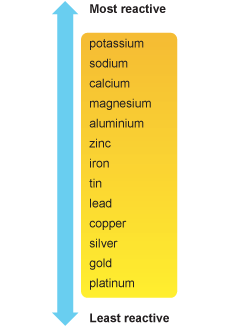What does the reactivity series tell us?
1 Answer
The reactivity series of metals compares the reactivity of metals. It can be used to predict whether one metal will replace another metal in a compound. The following is a very limited version of a reactivity series.

Use the reactivity series in order to determine if the following single replacement (displacement) reaction will take place.
Check the reactivity series.
As you can see, copper is above silver in the reactivity series, meaning it is more reactive than silver, and will replace the silver in the silver nitrate compound.
Let's if the opposite reaction can take place.
Check the reactivity series.
Silver is below copper in the reactivity series, meaning it is less reactive than copper, so silver will not replace copper. The way to indicate this is to write the equation as follows:

